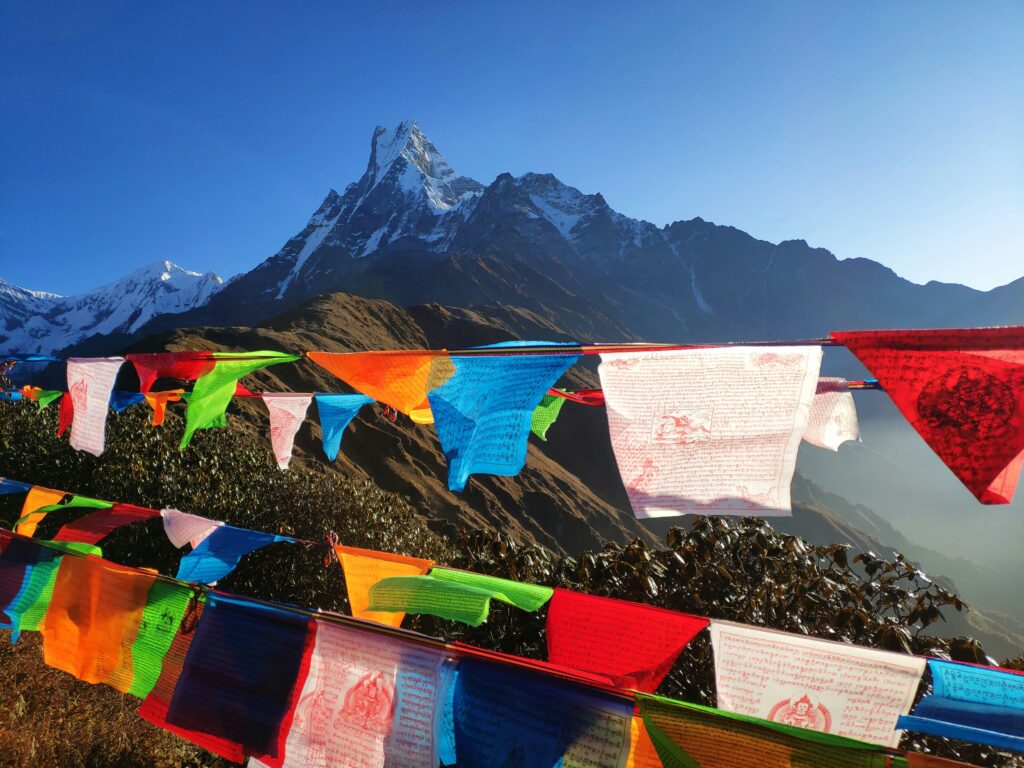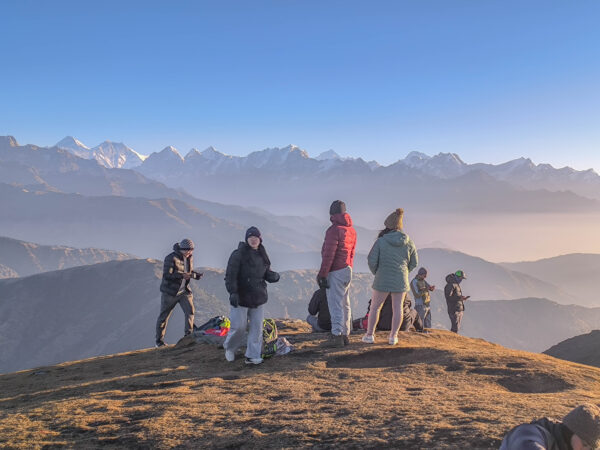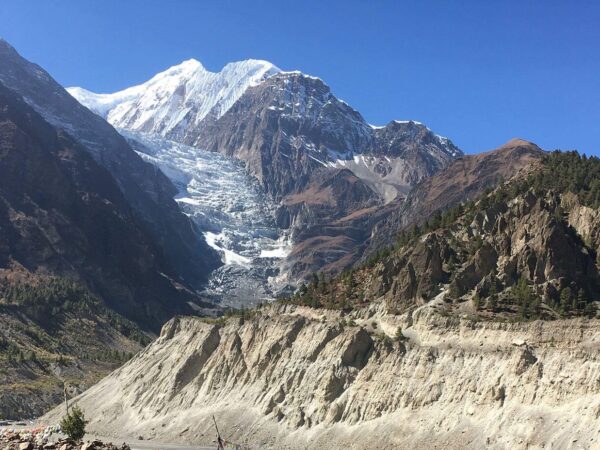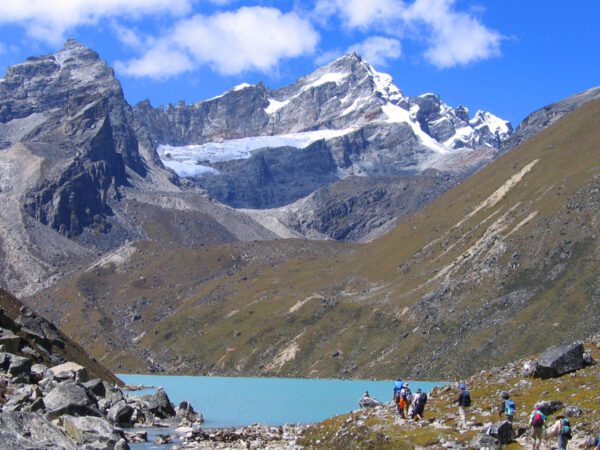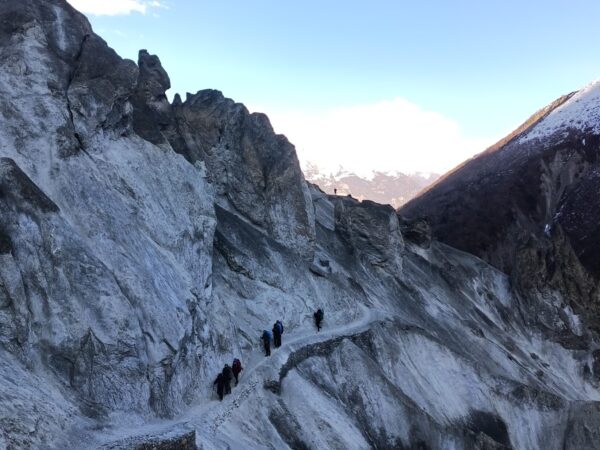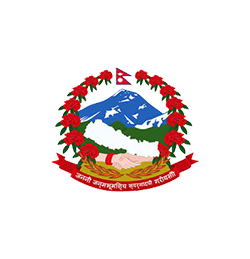Highlights
- Hike through woods of blossoming rhododendron (March-April)
- Take pleasure in a rather simple hike that many tourists miss.
- One of the most exquisite and intimate views of Mount Fishtail
- Savor the breathtaking views of the Mardi Himal, Machhapuchhre, and Annapurna
- Diversity in Nature and Culture
- See a variety of plants and animals
- Discover the Gurung people's ethnic culture
- Admire the breathtaking sunrise and sunset views of the Annapurna mountain range
- Take in the views of Pokhara's stunning Lake City
- Admire the breathtaking views of the valley below as you over several suspension bridges above raging rivers.
Overview
In recent years, the Mardi Himal Trek departing from Kathmandu has surged in popularity. Embark on this journey to behold stunning, up-close vistas of iconic peaks like Fishtail (Machhapuchre), Annapurna South, Mardi, and Huinchuli. Traverse through lush rhododendron forests and along a ridge leading to Fishtail, revered as a sacred mountain in Nepal.
This off-the-beaten-path trail promises an authentic Himalayan adventure, offering an immersive experience unlike any other. Regarded as one of Nepal’s finest short and accessible treks, reaching the Mardi base camp is immensely fulfilling.
Immerse yourself in local life and soak in the rich culture of the Gurung people as you traverse the Mardi Himal tea house trek in the Annapurna region.
Best Time to Trek Mardi Himal
Mardi Himal is an excellent trekking destination throughout the year due to its low altitude and relatively easy trails. However, to experience the trek at its best, consider visiting during the Spring (March-May) or Autumn (September-December) seasons.
Spring Season (March-May)
Spring is considered the prime time for trekking on the Mardi Himal trail. The rhododendron trees are in full bloom, filling the jungle with vibrant colors. The weather is typically clear, offering breathtaking views of the mountains, and the temperatures are comfortable for trekking.
Autumn Season (September-December)
Autumn is another ideal season for trekking Mardi Himal. This time coincides with Nepal’s festive season, attracting many domestic tourists. The days and nights are balanced in length, the temperatures are moderate, and the weather is generally clear, providing spectacular views of the mountain ranges.
Monsoon Season
While Mardi Himal is safe for trekking even during the monsoon season, be mindful of leeches. The area does not experience heavy rainfall, making it a viable option for trekking during this time.
Accommodation During the Trek
The Mardi Himal Trail offers ample accommodation with basic amenities. Newly built hotels are available along the pathway, providing satisfactory services, including hot showers and, in some lodges, internet facilities. The guesthouses and the forested trail offer breathtaking views of the mountains, making it easy to forget the limited city amenities.
Food During the Mardi Himal Trek
The food options on the Mardi Himal Trek are quite basic, but they aim to provide healthy and nutritious meals throughout the journey. An open menu is available, offering non-vegetarian, vegetarian, and vegan options. We recommend trying traditional Nepali food, especially Dal Bhat, as it is a healthier choice. You can also customize your meals by adding or removing ingredients according to your dietary preferences and restrictions.
Here’s a list of common foods available during the Mardi Himal Trek, typically served in the tea houses and lodges along the route. While options are more limited than in larger trekking areas, you’ll still find tasty and filling meals:
Traditional Nepali Dishes:
- Dal Bhat Tarkari (rice, lentil soup, vegetables; unlimited refills!)
- Gundruk with Dhindo or Rice (fermented leafy greens)
- Aloo Tarkari (spiced potato curry)
- Pickles (Achar) – often homemade
Western-Inspired Meals:
- Pasta (vegetarian or with egg/cheese)
- Mac and Cheese
- Spaghetti with tomato or mushroom sauce
- Pizza (simple toppings like cheese, tomato, onion)
- Fried Rice or Noodles (veg/egg/chicken options)
- French Fries or Mashed Potatoes
Breakfast Options:
- Tibetan Bread or Chapati (with jam, honey, or peanut butter)
- Pancakes (plain, apple, banana, or chocolate)
- Porridge (plain or with apple, cinnamon, or honey)
- Muesli with Hot Milk
- Boiled or Fried Eggs / Omelette
Drinks:
- Milk Tea (Chiya) – black, with milk, or ginger
- Coffee (Instant mostly)
- Hot Lemon or Honey Lemon Tea
- Herbal Tea
- Hot Chocolate
- Bottled or boiled drinking water
Snacks & Extras:
- Biscuits, Chocolates, and Energy Bars (available in villages)
- Popcorn
- Boiled Potatoes
- Seasonal fruits (if available)
Is this trek right for you?
If you’re short on time but still want to experience the magic of the Himalayas, the Mardi Himal Trek is a hidden gem you’ll love. It’s a relatively easy trek—perfect for beginners—but don’t let that fool you. You’ll still walk through enchanting rhododendron forests, pass by welcoming mountain villages, and follow quiet ridgelines with jaw-dropping views all around.
The real treat? Getting up close to the stunning Mt. Fishtail (Machhapuchhre), with sweeping views of the Annapurna and Dhaulagiri ranges right in front of you. It’s a short escape into the heart of the mountains—simple, peaceful, and unforgettable.
Mardi Himal Trek Itinerary
Day 1: Drive Kathmandu to Pokhara (822m, 6-7 hrs)
Day 2: Drive to Phedi, trek to Deurali (2,100m, 4-5 hrs)
Day 3: Trek to Low Camp (3,050m, 6-7 hrs)
Day 4: Trek to High Camp (3,580m, 3-4 hrs)
Day 5: Trek to Mardi Himal Base Camp (4,500m) & back to Badal Danda (3,210m, 7-8 hrs)
Day 6: Trek to Sidhing (1,700m), drive to Pokhara (4-5 hrs trek, 2-3 hrs drive)
Day 7: Drive to Kathmandu (1,400m, 6-7 hrs)
Mardi Himal Trek – 7 Days - Itinerary
Drive Kathmandu to Pokhara (822m, 6-7 hrs)
We start our journey with a 6/7-hour bus ride from Kathmandu to Pokhara, tracing the Trisuli and Marsyangdi Rivers amidst towering hills. Along the way, we pass through quaint towns, fertile agricultural lands, and dense forests. Weather permitting, glimpses of Manaslu Peak and Ganesh Himal may grace our bus journey.
Pokhara, a haven for tourists, boasts breathtaking natural and cultural wonders, including lakes, caves, Hindu and Buddhist temples, and stunning views of the Annapurna range. Upon arrival in Pokhara and checking into our hotel, you can venture out to explore this city of lakes.
Drive to Phedi, trek to Deurali (2,100m, 4-5 hrs)
After enjoying a delightful breakfast at our Pokhara hotel, we embark on a brief 1-hour drive to Phedi, the starting point of our hike. As we disembark and stretch our legs, our journey begins. Along the trail, we traverse villages, terraced fields, and stone steps.
At 1650 meters, Dhampus stands out as a prominent Gurung village adorned with traditional houses and stunning mountain vistas. Here, we pause for lunch, soaking in the breathtaking views of the Annapurna range. Post-lunch, our trek resumes towards Pothana village, then onward to Deurali, where we settle in for the night.
Trek to Low Camp (3,050m, 6-7 hrs)
After enjoying breakfast at our lodge, we set off on our hike. The trail winds through a verdant forest, speckled with rhododendron trees, until we arrive at Forest Camp at 2600 meters. Here, we pause for lunch, taking a moment to relax and loosen up our muscles before resuming our trek.
Continuing onward from Forest Camp, a few hours of hiking brings us to Low Camp at 3000 meters. Along the way, the awe-inspiring vistas of Mt. Machapuchhre (Mt. Fishtail) reward our efforts, offering ample opportunities to capture the scenery in photographs. As night falls, we settle into a cozy teahouse in Low Camp, where the sight of Mt. Machhapuchhre looms even more majestically overhead.
Trek to High Camp (3,580m, 3-4 hrs)
We wake up to the golden dawn, as sunlight spills over Mt. Machhapuchhre. After a delightful breakfast bathed in warm sunshine, we embark on the third day of our hike. With close-up views of Annapurna South and Hiunchuli, we ascend the challenging stone-carved steps to Badal Danda, perched at 3210 meters. Translated as "cloudy hill" in English, the name aptly describes this spot, often shrouded in clouds during afternoons and evenings.
From Badal Danda, the trail to High Camp (3580 m) steepens, leading primarily through expansive grasslands. This leg of the trek becomes exhilarating, offering breathtaking Himalayan vistas above and deep gorges below. Despite its brevity, today's hike is demanding, involving a 600-meter ascent over just 3–4 hours.
Upon reaching High Camp, we enjoy a satisfying lunch, settle into our teahouse rooms, and have the option to explore the surroundings or mingle with fellow hikers at the lodge. Evenings can be chilly, making dinner in a communal dining hall by a crackling fire a cozy necessity. After dinner, we retire early to prepare for an early-morning start on the next day's hike.
Trek to Mardi Himal Base Camp (4,500m) & back to Badal Danda (3,210m, 7-8 hrs)
Today, our eagerly anticipated journey to the majestic Annapurna range begins, culminating at the breathtaking Mardi Himal Base Camp (4500 m).
We set off early, embarking on a 2-hour trek to the Mardi Himal View Point. Prepare to be captivated by the stunning sunrise casting its glow on nearby snow-capped peaks like Mardi Himal (5587m), Annapurna I (8091m), Annapurna South (7219m), Hiunchuli (6441m), Baraha Shikhar (Mt. Fang) (7647m), Tent Peak (5695m), Singhachuli (6501m), Machapuchhre (6993m), and more.
After taking in the Himalayan sunrise, we continue along a ridge to the Upper Viewpoint and onward to Mardi Himal Base Camp. Here, the mountains seem incredibly close, offering breathtaking views of the ravine below that mirror the grandeur of the peaks. The trek from High Camp to Mardi Himal Base Camp takes around 4-5 hours, with the return journey lasting approximately 3-4 hours.
Following a satisfying meal, we pack up at High Camp and descend to Badal Danda, where we settle in for the rest of the day and night.
Trek to Sidhing (1,700m), drive to Pokhara (4-5 hrs trek, 2-3 hrs drive)
Today marks the descent day of your Mardi Himal journey, having conquered its challenges. Following breakfast, we leave Badal Danda, retracing our steps for about 2 hours until we reach Low Camp, pausing briefly before descending via a different route through lush forests and alongside gentle streams. After a pleasant 3-hour hike, we arrive at Sidhing, where we enjoy a leisurely lunch while awaiting our jeep.
The journey from Sidhing to Pokhara takes a couple of hours by jeep, offering a chance to relax and reflect on the trek's accomplishments. Pokhara welcomes us with its serene lakeside setting—a perfect spot to unwind, savor a lakeside meal, and toast to the successful completion of our adventure in the mountains.
Drive to Kathmandu (1,400m, 6-7 hrs)
After breakfast, we board a tourist bus at 8 am, embarking on a 6 to 8-hour journey to Kathmandu. And just like that, the 7-day trek to Mardi Himal concludes. We hope you enjoyed your time with us amidst the mountains.
Inclusions
What's included
- Airport transfers - pickup and drop off
- Standard hotel accommodation in Pokhara
- An Experience English speaking guide
- A porter to carry your luggage (1 porter for every 2 trekkers)
- All Meals (breakfast, lunch and dinner) and Teahouse accommodation during the trek
- Kathmandu - Pokhara - Kathmandu Deluxe Tourist Bus
- All required trekking permits (Annapurna Conservation Area Entry Fee and TIMS Card)
- Guide insurance with food and accommodation
- Basic Medical kits
- Farewell dinner
- Emergency Helicopter Evacuation Service Arrangement Only (should cover by your travel insurance)
- All required paper works and government taxes
What's not included
- International Flight
- Nepal Travel Visa Fee
- Personal Medical and Travel insurance (Should cover helicopter evacuation)
- Guide, Porter and Driver tips
- Personal Gears (equipment)
- Personal bill
- Lunch and Dinner in Kathmandu
- All other personal expense of beverages (hard and soft drinks)
- All other things not mentioned in the inclusion.
Equipment
Recommended Trekking Gears
Clothing
- Base Layers (Moisture-Wicking)
- Thermal tops and bottoms (polyester or merino wool)
- Lightweight long-sleeve shirts
- Insulating Layers
- Fleece jacket or pullover
- Down jacket (for high-altitude treks)
- Warm sweaters
- Outer Layers (Shells)
- Waterproof and windproof jacket (Gore-Tex or similar)
- Waterproof pants
- Trekking Pants
- Quick-dry pants
- Convertible hiking pants (zip-off into shorts)
- Trekking Shirts
- Lightweight and breathable T-shirts
- Long-sleeve shirts with UV protection
- Headwear
- Wide-brim hat or cap for sun protection
- Warm beanie for cold temperatures
- Buff or scarf for dust and wind
- Gloves
- Lightweight trekking gloves
- Insulated gloves for higher altitudes
- Socks
- Moisture-wicking trekking socks
- Thermal socks for colder regions
- Footwear
- Sturdy and waterproof trekking boots (well broken-in)
- Comfortable sandals or camp shoes (for evenings/rest days)
- Gaiters (optional, for snow or muddy trails)
Backpacks & Bags
- Backpack
- 40-50L capacity for multi-day treks
- Comfortable straps and rain cover
- Daypack
- 20-30L for short treks or carrying essentials during the day
- Duffel Bag
- Used if porters are carrying your gear (for organized treks)
- Dry Bags
- To keep electronics and clothes dry in wet conditions
Sleeping Gear
- Sleeping Bag
- 4-season sleeping bag (rated for -10°C to -20°C for high-altitude treks)
- Sleeping bag liner (optional, for extra warmth and hygiene)
- Sleeping Pad (if camping)
- Lightweight and inflatable or foam pads for comfort
Trekking Accessories
- Trekking Poles
- Adjustable and lightweight poles (essential for steep ascents/descents)
- Water Bottle/Hydration System
- Insulated bottle (to prevent freezing at high altitudes)
- CamelBak or similar hydration reservoir
- Water Purification
- Water filters, purification tablets, or UV sterilizers
- Sunglasses
- UV protection (Category 3 or 4 for snowy conditions)
- Headlamp
- With spare batteries (essential for early morning or late-night treks)
- Multi-tool or Knife
- For various small tasks
- First Aid Kit
- Bandages, blister patches, antiseptic wipes, painkillers, Diamox (for altitude sickness), etc.
- Lip Balm
- SPF-protected to prevent chapping
- Sunscreen
- High SPF for UV protection at higher altitudes
- Personal Toiletries
- Biodegradable soap, toothpaste, toothbrush, quick-dry towel, wet wipes, and toilet paper
Optional but Useful Items
- Camera
- To capture the stunning scenery (extra batteries and memory cards are a must)
- Snacks
- Energy bars, trail mix, or chocolate for quick energy boosts
- Power Bank/Solar Charger
- For charging devices in remote areas
- Books or E-Readers
- For downtime during rest days
- Earplugs
- To block out noise in lodges or camps
- Notebook/Journal
- To record your trek experience
Clothing Packing Tips
- Layering is key: It helps regulate your body temperature and adapt to changing weather.
- Avoid cotton: It retains moisture and dries slowly, which can lead to discomfort or hypothermia.
- Pack light: Only carry what is absolutely necessary to avoid unnecessary weight.
Gear Rentals in Nepal
If you're worried about carrying too much gear, trekking hubs like Kathmandu and Pokhara offer trekking equipment rentals and sales. You can find items like sleeping bags, down jackets, and trekking poles at reasonable prices. However, ensure you check the quality before renting.

